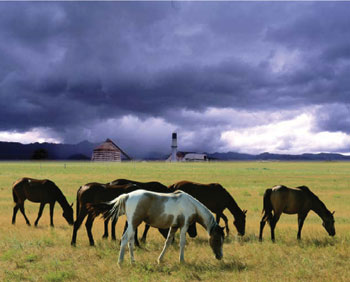
"Everyone talks about the weather," Mark Twain once said, "but nobody does anything about it." Nearly a century after Twain's death, we still can't do anything about the weather. Storms rage. Winds blow. We still talk about it, worry about it, get angry about it, celebrate it. But we can't change it. If you are not compelled by a job or an avocation to be outside, the weather is likely only an occasional nuisance. But if your life includes horses, weather's importance rises like the temperature in August. Likewise so does the importance of protecting horses in bad weather. In summer, thunderstorms pack the biggest bag of worries for horse owners. They can be deadly to people and livestock. And they can quickly destroy barns.
Dr. Craig Shultz, Executive Director of Pennsylvania's Animal Health and Diagnostic Division, is all-too-familiar with the dangers thunderstorms bring. He and his family lost a beloved horse to a lightning strike last year. "You know looking back on our situation we only had four horses at the time, and a big pasture, a hill pasture with lower access. This was a thunderstorm that happened in late March. We had a three-sided metal run-in shed on the top of the hill and they went there."
Shultz said the shed was not grounded. The Haflinger that died was the lowest status horse among the horses in the pasture, and Shultz says that he was not actually inside the shed with the other three horses. The other three horses were unharmed.
What Works Best
It's not always practical to try to bring horses in from the pasture when storms erupt. If it's dangerous for horses to be in the field, it's dangerous for the people who might try to bring the horses in. That doesn't mean horses can't be protected, though. It takes planning before the storm season arrives. There are no solutions that will be 100 per cent effective all the time. But perfect, as they say, is the enemy of ideal.
Cornell University's Cooperative Extension Service offers several suggestions to help farm owners protect livestock during severe storms, including:
- Fence off single trees in pastures to prevent animals from congregating under them. Often a single tree is an ideal target for lightning. Animals are less likely to be struck if they're sheltered near a grove of trees.
- Fix loose siding, roofing, fence posts, etc., with a company like Manchester roofers as these can become dangerous projectiles in high winds;
- Secure loose equipment and materials like buckets, tools, etc. These too can become dangerous if airborne.
Lightning Doesn't Strike Twice…Or Does It?
How many times have you heard that lightning doesn't strike the same place twice? It's a myth. "Meteorologists have pretty much disproved that theory," Shultz says. Albert Peterlin, the former chief meteorologist for the United States Department of Agriculture (USDA) told The Horse.com in 2001 that lightning is not as random as it appears. "Lightning is not just a random event, but an opportunist taking advantage of a preferred pathway. Where lightning has struck a tree in the past, it will likely hit again. An area of pasture that has been deadly once could be again. With lightning, the past is a prologue to the future."
Shultz says that hoofed animals are especially vulnerable during thunderstorms, by virtue of their physiology. "Hoofed animals are very prone to electrocution," he explains. "First of all they're on wet ground, which is a wonderful conductor. They've got hooves, which are great conductors, and those hooves are pressed down into the ground by the sheer weight of the animals themselves."
According to Peterlin in The Horse.com, "The primary goal of a lightning bolt is to seek the easiest pathway to Earth. Any pathway offering less resistance than air standing between the bolt in the blue and the Earth's surface is at risk. The most likely area for a strike is toward higher elevations."
That, explains Shultz, is why sheds should be at lower elevations in pastures. That doesn't necessarily mean the horses will go into the sheds, though. "Hopefully they will develop a pattern of going to that area in bad weather. You have to observe their behavior and create some incentives for them to go there." He says that equine behaviorists have observed that horses are not particularly bothered by thunder and lightning, but it's the driving rain and wind that compels them to seek shelter near trees and in sheds.
He also noted that water tanks, if they're metal, should not be located at the top of hills, but should be on lower elevations and protected. Although lightning is not necessarily more attracted to metal, metal is a great conductor of electricity. Lightning tends to strike the highest object, which could be a metal tank at the top of a hill.
A Beloved Horse with a Mission
For Shultz and his family that freak March thunderstorm was especially painful. The Haflinger that died had been a beloved companion. "The gelding was a horse we had raised and trained specifically for my special needs son. He was a great driving horse for my boy." They've got a new Haflinger now, a mare, and Shultz says she's going to be a good fit for the family.




